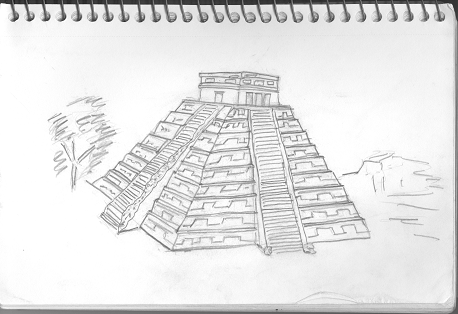I have been enjoying a book by Edward O. Wilson, “Consilience the unity of knowledge.” In this book, Dr. Wilson explores some really interesting ideas about how we think, and how that might be a reflection of how we are put together biologically as the result of evolutionary pressures. One of the topics of interest to me is a discussion that perhaps art is in alignment with our biology as evidenced by the presence of certain archetypes and techniques in art that seem to have been common across cultures for tens of thousands of years. There are certain things about “art” that “feel” compelling and connect us to emotional stirrings.
As I was contemplating that I started to wonder, based upon not a lot more than idle musings, if perhaps we automatically build mental models of the world around us that as similar to three dimensional wire models that are the basis of cad drawing packages on drafting computers. When I try to sketch something, perhaps a building or a table, I automatically do so by drawing lines representing the edges of things. I did this for perhaps fifty years before it finally dawned on me that there are no lines in the real world. Somehow I thought I was “tracing” actual lines located along the edges of things. Obviously there are just changes in color, shading, texture and things like that – but there are no lines. However, even with that rudimentary (and rather obvious) insight, it still feels compelling to me that I am somehow drawing lines where there are lines. Maybe, but I might be wrong here, there ARE lines, but they are embedded in the way my brain simplifies, stores and manipulates our perception of the world. Maybe we somehow map the edges as lines, that can then be shifted, manipulated, rotated and simplified in our “mind’s eye.”
I surprised myself a few years ago while sitting under the shade of a tree sketching the great pyramid chicen itza. I was sitting on the ground level with the base of the pyramid, trying my best to accurately represent what I was seeing. I wasn’t trying to be “artsy” by drawing an impossible representation, I was paying attention to angles, perspective, shadows, and all that in an attempt to draw what I was seeing. When I finished my drawing I was kind of pleased with the effort, it looked very much like what I as seeing – but … oops, it was drawn from a position several hundred feet in the air, far above my head.

The really amazing part of this was that I hadn’t noticed the rather dramatic error while making the drawing. I thought I was following what I was seeing, but rather obviously I was doing something quite different, I was somehow or another following what I was seeing in my “minds eye” – but not in my physical eye.
The amazing thing was that I could have drawn it from many different angles without having to move to a new location, some how or another I already knew what it looked like from different directions.
An interesting side to this is that many of the great masters started their drawings with pencil sketches consisting of lines indicating the location of edges. They then paint over their lines, hiding them from view as they fill in the spaces between the lines – perhaps somewhere in the physical architecture of our brain a “wire frame” representation exists. From an evolutionary point of view that would be a very efficient means for modeling, remembering, and “imagining” the physical space we live within.
There is nothing of particular value here, I am just pondering the distinction between what we see and what we “see”. It is clear that “real” light particles hit our eye. (Whatever that might mean from the point of view of modern physics.) These light “particles” influence chemical processes in our nerves that transmit coded information to our brain. Our brain takes those nerve impulses and somehow builds a “mental model” (that is very similar to a dream) – and that mental model is actually what we “perceive.” We don’t actually see anything, we only “see” what has been created by our brain and nerves after a whole lot of filtering, processing, filling in details, and other adjustments have been made. I have always been curious about what we are adding on our own, and what we are filtering out (removing) that is actually there.